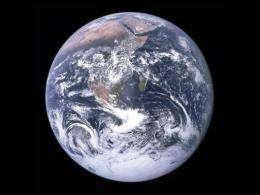Bus-sized asteroid shaves by Earth

An asteroid about the size of a bus shaved by Earth on Friday in what spacewatchers described as a "near-miss," though experts were not concerned about the possibility of an impact.
The asteroid, named 2012 BX34, measured between six and 19 meters in diameter (20 to 62 feet), said Gareth Williams, associate director of the US-based Minor Planet Center which tracks space objects.
The asteroid, which had been unknown before it popped into view from a telescope in Arizona on Wednesday, came within about 60,000 kilometers (37,000 miles) of Earth on Friday at about 1500 GMT, he said.
"It's a near miss. It makes the top 20 list of closest approaches ever observed," Williams told AFP.
NASA had announced on Twitter on Thursday that the asteroid would "safely pass Earth on January 27."
Williams explained that since the asteroid was so small, it could only be detected when it was close to the Earth, but that the fly-by, while a surprise, was not terribly uncommon.
"This came about a sixth of the distance from the Moon," he said. "In the past year we have had some 30 objects that were observed to come within the orbit of the Moon."
Williams said his pager went off in the middle of the night Wednesday after the asteroid was first sighted, but once he checked he went right back to sleep because he knew it would not hit Earth from its projected distance.
But where it goes next is less certain.
"If we have radar on it from last night then we can probably predict it decades into the future," he said.
"If we don't have radar, then we only have a two- to three-day arc of observations and extrapolating that into the future will be very uncertain."
However, since the asteroid is so diminutive, it poses little threat to the vast Earth, he added.
"This object is so small that even if it hits us the next time around it won't survive passage through the atmosphere in one piece," Williams said.
"Objects in that size range -- six to 19 meters -- will typically break up due to the force of entering the atmosphere. All that may remain are a few fist- or football-sized rocks that make it to the ground as meteorites."
In November last year, a much a larger asteroid called 2005 YU55 made its closest fly-by of Earth in 200 years.
The near-spherical asteroid, 1,300 feet (400 meters) in diameter, passed by at a distance of 201,700 miles (324,600 kilometers), as measured from the center of Earth, NASA said.
In 2008, a small asteroid estimated to be a few meters (yards) wide sparked a fireball in the night sky plunged down over Sudan, scattering fragments over the Nubian desert, NASA said.
(c) 2012 AFP




















